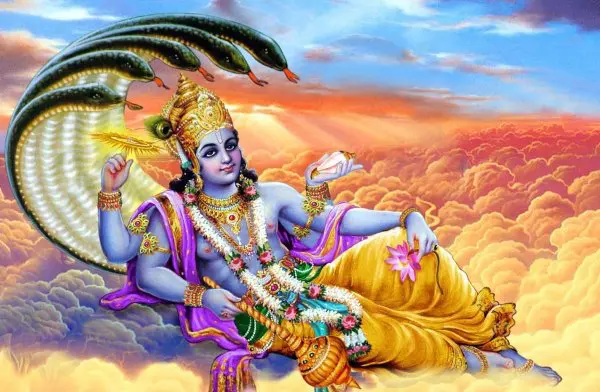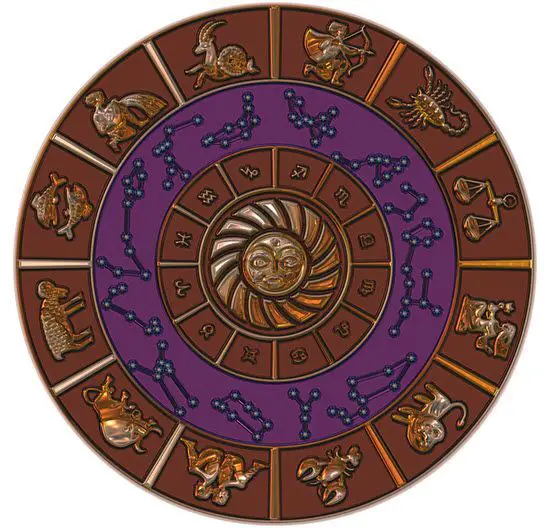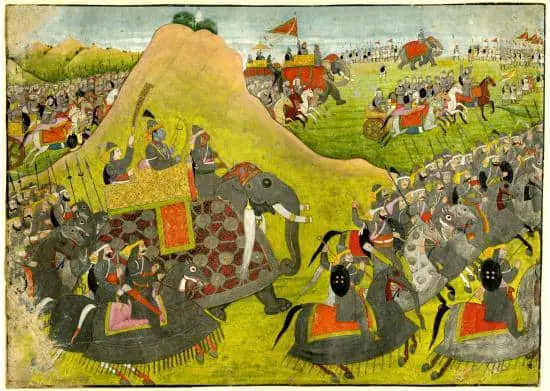The Vishnu Purana is an ancient religious text of the Hindus. It is one of the most important Pancharatra texts in the Vaishnavism literature corpus. It is regarded as one of the 18 Mahapuranas. This post is about Vishnu Purana and its teachings.
The Vishnu Purana manuscripts are present in this modern era in many versions. Unlike other major Puranas, the contents in Vishnu Purana is presented in Pancalaksana format that includes:
- Sarga (cosmogony)
- Pratisarga (cosmology)
- Vamśa (the mythical genealogy of Gods, Sages, and Kings)
- Manvantara (cosmic cycles)
- Vamśānucaritam (legends related to the ancient kings)
The Vishnu Purana is also notable for being the earliest Purana that was translated and published in 1864 CE by HH Wilson.
The Vishnu Purana is one of the shortest Puranas that contains about 7000 verses in extant versions. It is centered on Lord Shri Vishnu and his incarnations (avatars) as Krishna. However, it also praises Lord Brahma and Lord Shiva and emphasizes that they are one with Lord Vishnu.

Like all other major Puranas, the authorship of Vishnu Purana is attributed to Sage Veda Vyasa. It has estimated that its composition range from 1st millennium BCE to 2nd-millennium CE. The Padma Purana has categorized Vishnu Purana as a form of Sattva Purana that represents goodness and purity.
The Vishnu Purana consists of six parts that are known as aṃśas and 126 adhyāyas or chapters. Its first part has 22 chapters, the second part has 16 chapters, and the third part has 18 chapters, while the fourth part consists of 24 chapters. Its fifth part is the longest with 38 chapters, and the sixth part is the shortest with eight chapters.
Moreover, scholars believe that the original Vishnu Purana had 23,000 verses. However, now, the surviving manuscripts consist of just 7000 verses. The text is written in metric verses or Shlokas.
Table of Contents
Contents of Vishnu Purana
Vishnu Purana begins with the conversation between Sage Maitreya and his Guru Parashara, in which the sage asks, “What is the nature of this universe and everything in it?”
The First aṃśa: Cosmology
The first Amsha (part) in the Vishnu Purana deals with the creation, maintenance, and destruction of the Universe. Here, the Hindu God Vishnu is presented as the central element. The 22 chapters of this first part contain reverence and worship of Vishnu as a means for liberation.
Lord Vishnu is described as Hari, Madhava, Janardana, Achyuta, Hrishikesha, and others. He is the Soul (Atman) within every living being. The chapters 1.16 to 1.20 of the Vishnu Purana present the legend of Prahlad, who is ultimately saved by Lord Vishnu.
The Second aṃśa: Earth
This part of the text contains the theory of the earth, its seven continents, and seven oceans. It describes major mountains, including Mount Meru, Mount Mandara, and many other mountains. It also describes “Bharata-Varsha” (the country of Bharata) along with its various rivers and diverse people.
The seven continents have been named as Jambu, Saka, Kusha, Plaksha, Salmala, Krauncha, and Pushkara. It states that these continents have been surrounded by different types of liquids such as saltwater, freshwater, liquid yogurt, sugarcane juice, wine, clarified butter, and milk.
In this part of the Vishnu Purana, you get a description of the spheres that are located above the earth. It talks about the planets, the sun, and the moon. The four chapters from 2.13 to 2.16 describe the legends of King Bharata, who left his throne and led the life of Sannyas. These legends are similar to those found in section 5.7 to 5.14 of the Bhagavata Purana.
The Third aṃśa: Time
This part of the Vishnu Purana describes the theory of Manvantara or Manus Ages, each equating to about 4.3 million years. The basic principle that underlies this theory is that everything is cyclic. So, each Yuga starts, matures, and then dissolves.
The text states that Six Manvantaras have already passed. So, the present age is the Seventh Manvantara. In each age, the Vedas are arranged into four. This has occurred twenty-eight times already. Veda Vyasa organized this eternal knowledge with the aid of his students.
The text presents the emergence of Vedic schools and describes the ethical duties of the four Varnas in the four stages of life in each human being. It also describes the wedding rituals and Shraddha Karma (the rites that are performed in honor of ancestors). All this has been described in detail from chapter 2.8 through 2.16.
The Vishnu Purana states that the Brahmins should study Shastra, worship Gods, and should perform libations on behalf of others. It states the duties of Kshatriyas as they should maintain arms and protect the earth. Vaishya should do commerce and farming. Lastly, Shudra should do mechanical labor and service other Varnas.
The text asserts that all Varnas should do good to others. They should never abuse others and should not speak untruth. They should not steal other’s property, never covet another person’s wife, never have ill-will towards another person, and should not slay any living being, including humans.
The text states that anyone who performs the above duties is the best worshipper of Lord Vishnu.
The text also describes the four stages of life as –
Brahmacharya (student), Grihastha (householder), Vanaprastha (retirement), and Sannyas (renunciation).
There are chapters on Shraddha describing the rites that are associated with death in a family.
This part ends with the legend of Vishnu through Mayamoha, helping the Devas win over Asuras.
The Fourth aṃśa: Dynasties
This part is 24 chapters long and presents mythical royal dynasties, starting with Brahma and following it up with solar and lunar dynasties, concluding with Parikshit that is asserted as the “current king.” It also describes various legends related to mythical characters, including the likes of Mandhatri, Narmada, Sage Kapila, Janaka, Rama, Satyavati, Bharata, Puru, Yadu, Devaka, Kuru, Bhisma, and others.
The Fifth aṃśa: Krishna
The fifth section is the longest part of the Vishnu Purana, containing 38 chapters. It describes the legend of Krishna as an avatar of Lord Vishnu. It contains the story of Krishna’s birth, his childhood stories, his exploits, and his pursuit of ending the tyranny of demon king Kamsa. These stories are similar to the legends that have been described in the Bhagavata Purana and several other Puranas.
The Sixth aṃśa: Liberation
This is the last part of the Vishnu Purana, and it is the shortest with eight chapters. The initial chapters assert that Kali Yuga is vicious and cruel filled with evilness creating suffering. However, Kali Yuga is also excellent as one can refuse to join evil and take shelter in the name of Lord Vishnu and thus achieve salvation.
The last chapters are devoted to Yoga and meditation, which are means to Vishnu’s devotion. It states that one can achieve union with the Brahman by practicing virtues such as compassion, truth, honesty, self-restraint, and study of Holy Scriptures.
The text lists out five Yamas, five Niyama, Pranayama, and Pratyahara. The text states that pure and perfect soul attains union with Vishnu and thus achieves liberation. The final chapter asserts itself as an “imperishable Vaishnava Purana.”
Vishnu Purana Teachings
The Vishnu Purana has been regarded as one of the oldest of Hindu Puranic literature and is dated to the first century BCE. It has been presented as a dialogue between Sage Parashara and his disciple Maitreya.
It is thought that Sage Parashara narrated the Vishnu Purana to his son Veda Vyasa who then wrote it in the present form in six parts and 126 chapters. This text is devoted to Lord Vishnu and talks mainly about five subjects such as:
- The creation
- Destruction and renovation of the world
- Royal Dynasties
- Reigns of Manus
- Genealogies
The text tells us that:
- Narayana engages itself with the creation of 14 worlds (within the universe) as Brahma
- He sustains, maintains, and preserves the Universe in the form of Vishnu
- As Narayana, he destroys the universe at the end of a great eon known as Maha-Kalpa.
The text also talks about stories of battles that were fought between Asuras and Devas, stories of legendary kings, avatars of Lord Vishnu, legends of Rama, Kapila, Nimi, and Janaka, the story of Dhruva, the famous story of Prahlad, Sun, Yama (the God of death), famous kings from ancient dynasties, the four stages of life and the churning of the ocean.
It talks about the events in the life of Lord Krishna, his birth, childhood, and further. The last part tells about Kali Yuga and its traits.
It states that:
- Brahma is the Creator, Vishnu is the Preserver, and Shiva is the Destroyer are the three in one.
- The Supreme Soul pervading the Universe is the fundamental cause
- Vishnu is the central soul of the Universe
Some important questions related to Vishnu Purana
Who wrote Vishnu Purana?
Sage Veda Vyasa is said to be the author of Vishnu Purana.
How was Vishnu born?
As per the Hindu belief, there is only one Supreme God known as Parambramh. He is without any form or attributes. His physical form is regarded as Maheshwar or Sadashiv, and Shakti originates from it in the form of Durga/Prakriti.
It is from Sadashiv and Prakriti that Lord Brahma, Lord Vishnu, and Rudra are born. Vishnu Puran states that Lord Vishnu first came into being and from his navel came out a lotus bearing Brahma in it, and out of his left body came Shiva.
According to Vishnu Purana who was the wife of Surya?
According to Vishnu Purana, Sandhya was the wife of Surya Deva. However, Surya Deva has one more wife named Chhaya, who was the shadow of Sandhya.
Well, that’s all we have for you in this post on Vishnu Purana. We hope that you found the post useful and full of information. Thanks for visiting. We welcome your comments and suggestions. Please remember and share the post across popular social network channels.






